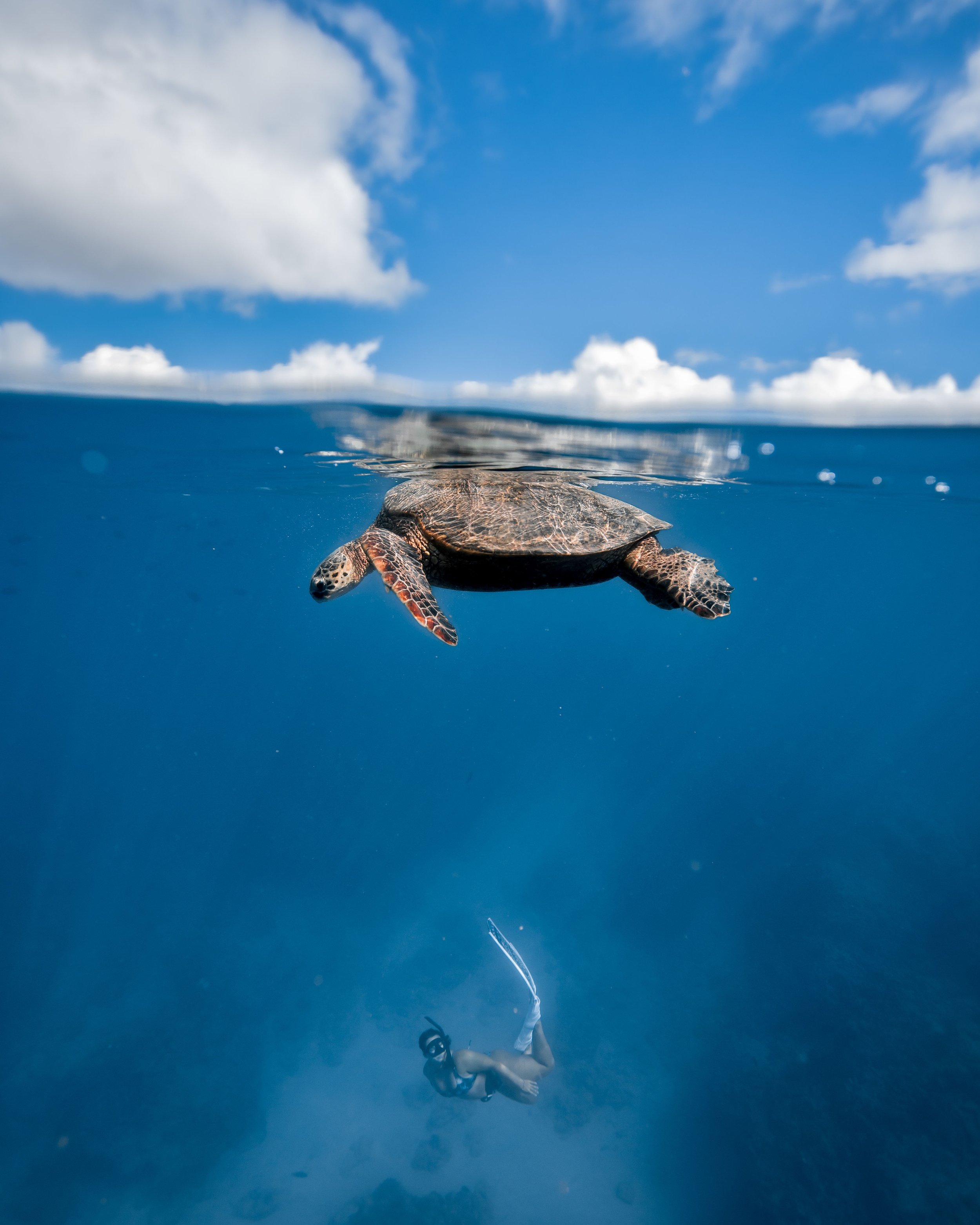
Hawaiian Green Sea Turtles
Frequently Asked Questions
1. What are Hawaiian Green Sea Turtles?
The Hawaiian Green Sea Turtle, known locally as "Honu," is a large marine turtle species native to Hawaii. They are known for their greenish-colored fat, which gives them their name, and are one of the most common sea turtles in Hawaiian waters.
2. Where can I see Hawaiian Green Sea Turtles?
Hawaiian Green Sea Turtles are often seen in the shallow coastal waters around the Hawaiian islands, particularly in areas with coral reefs where they feed on algae and seagrass. Popular spots include Turtle Canyon in Waikiki , Laniakea Beach on Oahu’s North Shore, and Hanauma Bay on Oahu.
3. What do Hawaiian Green Sea Turtles eat?
Green sea turtles primarily feed on algae and seagrass, making them one of the few herbivorous sea turtle species. Their diet contributes to the health of coral reefs by preventing algae overgrowth.
4. Are Hawaiian Green Sea Turtles endangered?
Yes, Hawaiian Green Sea Turtles are listed as a threatened species under the Endangered Species Act. While their population has been recovering due to conservation efforts, they still face threats from habitat loss, pollution, and illegal harvesting.
5. When is the best time to see Hawaiian Green Sea Turtles?
Green sea turtles can be seen year-round in Hawaii, but they are most active during the day when they come to the surface to breathe, bask on the beaches, or forage for food.
6. How close can I get to a Hawaiian Green Sea Turtle?
It is important to maintain a respectful distance from sea turtles to avoid disturbing them. The law requires maintaining a distance of at least 10 feet (3 meters) both in the water and on land. Touching or harassing turtles is illegal and can result in fines.
7. Do Hawaiian Green Sea Turtles nest on the beaches of Oahu?
While most Hawaiian Green Sea Turtles nest on the Northwestern Hawaiian Islands, some nesting activity has been observed on Oahu and other main islands. Nesting season typically occurs between May and September.
8. What should I do if I see a sea turtle on the beach?
If you see a turtle on the beach, it’s best to observe from a distance. Do not attempt to touch or feed the turtle, and avoid making loud noises or sudden movements that might startle it. These turtles often come ashore to rest and bask in the sun.
9. Are there any cultural significance of Honu in Hawaii?
Yes, the Honu holds a special place in Hawaiian culture and mythology. They are considered a symbol of good luck, endurance, and long life. Many Native Hawaiians believe that sea turtles are guardian spirits, known as "aumakua."
10. How can I help protect Hawaiian Green Sea Turtles?
You can help protect sea turtles by following guidelines for respectful wildlife viewing, avoiding single-use plastics, participating in beach cleanups, and supporting conservation organizations dedicated to turtle protection.
11. What are the threats to Hawaiian Green Sea Turtles?
The primary threats to Hawaiian Green Sea Turtles include habitat destruction, entanglement in fishing gear, ingestion of marine debris, illegal poaching, and diseases like fibropapillomatosis, which causes tumors on their bodies.
12. Can I swim with Hawaiian Green Sea Turtles?
Yes, you can swim with sea turtles in areas where they are commonly found, such as Turtle Canyon during our snorkel tours. However, it is crucial to keep a safe distance and avoid touching or chasing the turtles to prevent stress or harm to them.
13. Are there any laws protecting Hawaiian Green Sea Turtles?
Hawaiian Green Sea Turtles are protected under the Endangered Species Act and Hawaii state law. It is illegal to harass, harm, or kill these turtles, and violators can face significant fines and penalties.
14. How long do Hawaiian Green Sea Turtles live?
Hawaiian Green Sea Turtles have a long lifespan, often living 60 to 70 years, and sometimes even longer in the wild. They reach sexual maturity at around 25 to 35 years of age.
15. What should I do if I find an injured or stranded sea turtle?
If you find an injured or stranded sea turtle, do not attempt to move or touch it. Instead, contact local authorities or the NOAA Marine Wildlife Hotline to report the sighting so that trained professionals can provide assistance.
16. Can I see baby turtles in Hawaii?
Baby turtles, or hatchlings, are less commonly seen as they typically emerge at night and make their way to the ocean quickly after hatching. Most nesting occurs on remote beaches in the Northwestern Hawaiian Islands, but some hatchlings may be observed during nesting season on Oahu and other main islands.
17. How can I tell the difference between a male and female Green Sea Turtle?
Adult male Green Sea Turtles can be distinguished from females by their longer tails, which extend beyond the back flippers. Females have shorter tails and tend to have a slightly smaller body size than males.
18. What is the significance of Turtle Canyon for sea turtles?
Turtle Canyon is a popular snorkel site near Waikiki where Hawaiian Green Sea Turtles gather to feed and rest. The area’s abundant coral reefs and underwater landscapes make it an ideal habitat for turtles and a prime spot for snorkeling enthusiasts.
19. Can I photograph or take videos of the turtles?
Yes, you can take photos and videos of the turtles, but be sure to do so from a respectful distance without using flash photography, which can startle or harm the turtles.
If you have any other questions or need further information, feel free to contact us! We're excited to share the beauty of Hawaiian Green Sea Turtles with you on our tours.
